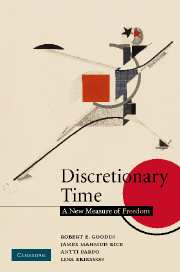Book contents
- Frontmatter
- Contents
- List of figures
- List of tables
- Preface
- Part I Introduction
- Part II Time pressure
- Part III Welfare regimes matter
- Part IV Gender regimes matter
- Part V Household regimes matter
- 13 How household regimes differ
- 14 The difference that household rules make
- 15 The difference that states make
- 16 Alternative household rules and temporal autonomy
- Part IV Conclusions
- Appendix 1 Methodology
- Appendix 2 Data
- Bibliography
- Index
16 - Alternative household rules and temporal autonomy
Published online by Cambridge University Press: 28 October 2009
- Frontmatter
- Contents
- List of figures
- List of tables
- Preface
- Part I Introduction
- Part II Time pressure
- Part III Welfare regimes matter
- Part IV Gender regimes matter
- Part V Household regimes matter
- 13 How household regimes differ
- 14 The difference that household rules make
- 15 The difference that states make
- 16 Alternative household rules and temporal autonomy
- Part IV Conclusions
- Appendix 1 Methodology
- Appendix 2 Data
- Bibliography
- Index
Summary
The lessons of the previous chapters are as follows:
People can increase or reduce the amount of discretionary time available to them by joining together as a couple, by having children or by divorcing. Let us call that the ‘household form’ component of our conclusions.
People can increase or reduce the amount of discretionary time available to them by operating on different rules. Let us call that the ‘household rules’ component of our conclusions.
The amount of discretionary time people can gain or lose by altering the form or rules of their household can be affected by prevailing public policies and social norms in their country. Let us call that the ‘state and society’ component of our conclusions.
Part of the latter is the way in which discretionary time of divorcing parents can be affected by the rules their state imposes on divorce. Let us call that the specifically ‘divorce rules’ component of our conclusions.
Private choice matters
The first two sets of conclusions speak to the issue of what individuals and couples can do to affect the amount of discretionary time they have.
Basically, there are two things they can do. First, they can choose to live in one form of household or another: whether alone or with a partner; whether with children or without them. Second, they can choose the rules on which their household operates: whether partners will share household responsibilities equally, or whether one (and if so, which) will be breadwinner while the other stays at home, or something in between.
- Type
- Chapter
- Information
- Discretionary TimeA New Measure of Freedom, pp. 254 - 258Publisher: Cambridge University PressPrint publication year: 2008



